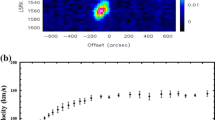Abstract
The standard \(\Lambda \)-cold dark matter (\(\Lambda \)CDM) cosmological model suggests that the universe contains an abundance of dark energy and CDM. The fluctuations in the initial distribution of dark matter collapse to form dense gravitationally bound dark matter halos which evolve through repeated mergers of galaxies. In this work, open simulation source code GADGET-2 based on smooth particle hydrodynamics approach is used to study the phenomenon of two merging galaxies consisting of dark matter and gas. Also, an analysis of dark matter simulation is done for the halo mass function. By ROCKSTAR code and compiling it with the same cosmological parameters of GADGET-2 and N-GenIC, the simulation results with the ‘Tinker mass function’ are compared.




Similar content being viewed by others
References
Aarseth S. J. 2003, Gravitational N-Body Simulations (Cambridge, UK: Cambridge University Press)
Barnes J., Hut P. 1986, Nature, 324, 446
Behroozi P. S., Wechsler R. H., Wu H.-Y. 2012, The Astrophysical Journal, 762, 109
Fidler C., Kleinjohann A., Tram T., Rampf C., Koyama K. 2019, Journal of Cosmology and Astroparticle Physics, 2019, 025
Iffrig O., Hennebelle P., et al. 2015, Astronomy and Astrophysics, 576, A95
Klypin A., Prada F., Yepes G., Heß S., Gottlöber S. 2015, Monthly Notices of the Royal Astronomical Society, 447, 3693
Macpherson H. J., Price D. J., Lasky P. D. 2019, Phys. Rev. D, 99, 063522
McClintock T. 2019, Halo mass function, https://cluster-toolkit.readthedocs.io/en/latest/source/massfunction.ht ml#tinker-mass-function
Mo H., van den Bosch F., White S., et al. 2010, Galaxy formation and evolution (New York: Cambridge University Press)
Molnar S. M. 2016, Frontiers in Astronomy and Space Sciences, 2, 7
Murray S., Power C., Robotham A. 2013, HMFcalc: An Online Tool for Calculating Dark Matter Halo Mass Functions, arXiv:1306.6721
Myers J. M., Snyder B., Rusthoven M., The L.-S., Hartmann D. H. 2010, The Astrophysical Journal, 723, 1057
Ossenkopf V., Klessen R. S., Heitsch F. 2001, Astronomy & Astrophysics, 379, 1005
Peirani S., Dubois Y., Volonteri M., et al. 2017, Monthly Notices of the Royal Astronomical Society, 472, 2153
Prialnik D., et al. 2000, An Introduction to the theory of Stellar Structure and Evolution (Cambridge: Cambridge University Press)
Robertson B., Banerji M., Brough S., et al. 2019, Nat. Rev. Phys., 1, 450
Singh M. 2013, N-body Techniques & Tools, http://astro.phy.vanderbilt.edu/ sinham/Chapter2.pdff
Somerville R. S., Davé R. 2015, Annual Review of Astronomy and Astrophysics, 53, 51
Springel V. 2005a, Monthly Notices of the Royal Astronomical Society, 364, 1105
Springel V. 2005b, User guide for GADGET-2, https://wwwmpa.mpa-garching.mpg.de/gadget/users-guide.pdf
Springel V., White S. D. M. 1999, Monthly Notices of the Royal Astronomical Society, 307, 162
Springel V., Yoshida N., White S. D. 2001, New Astronomy, 6, 79
Tinker J., Kravtsov A. V., Klypin A., et al. 2008, The Astrophysical Journal, 688, 709
Vogelsberger M., Marinacci F., Torrey P., et al. 2020, Nat. Rev. Phys., 2, 42
Weinberg D. H., Colombi S., Davé R., Katz N. 2008, The Astrophysical Journal, 678, 6
Winther H. A., Schmidt F., Barreira A., et al. 2015, Monthly Notices of the Royal Astronomical Society, 454, 4208
Acknowledgements
The author express his gratitude to C-DAC Pune for providing the server ‘Paramshakti’ to run the simulations. Also would like to take this opportunity to express my profound gratitude to Mr. Manodeep Sinha (Research Assistant Professor, Department of Physics and Astronomy, Vanderbilt University) for his exemplary guidance, monitoring and constant encouragement throughout the project via e-mail. Also, her sincere gratitude to my project guide, Dr Ram Prasad Prajapati for his endless support and counsel throughout her M.Sc. and thesis work. Finally, she is grateful to Volker Springel for developing GADGET-2 and making it available as a public source.
Author information
Authors and Affiliations
Corresponding author
Additional information
This article is part of the Special Issue on “Waves, Instabilities and Structure Formation in Plasmas”.
Rights and permissions
About this article
Cite this article
Tulasi, K. N-body simulation of galaxy merger containing dark matter using GADGET-2. J Astrophys Astron 43, 69 (2022). https://doi.org/10.1007/s12036-022-09859-y
Received:
Accepted:
Published:
DOI: https://doi.org/10.1007/s12036-022-09859-y




